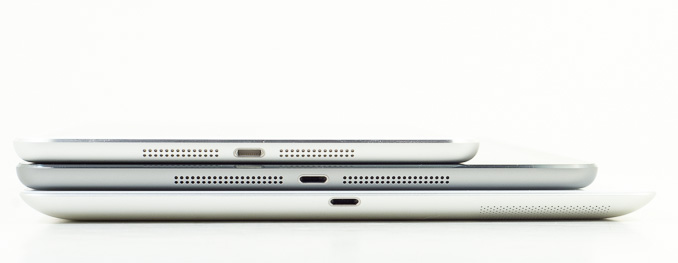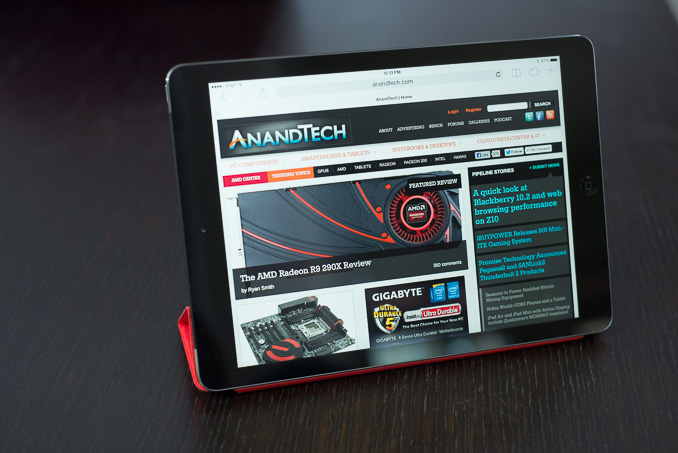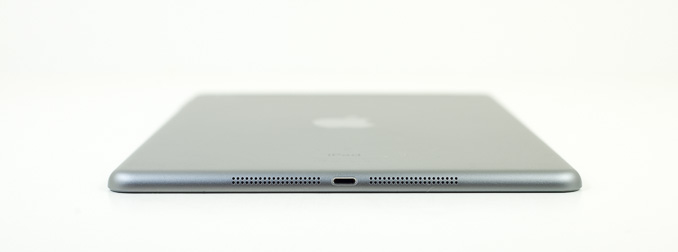The iPad Air Review
by Anand Lal Shimpi on October 29, 2013 9:00 PM ESTFinal Words
Two weeks ago I had all but written off the bigger iPad. It was too bulky and just no where near as portable as the iPad mini. Once the latter gets a Retina Display and equal hardware across the board, why would anyone consider the bigger model?
The iPad Air changed my perspective on all of that. It really does modernize the big iPad. While I suspect there are still going to be a lot of users who prefer the smaller form factor of the iPad mini with Retina Display, I do feel like there are those users who will continue to appreciate all of the benefits that go along with having a larger display. Text is easier to read, particularly on desktop versions of websites. Photos and videos are larger and thus more engaging as well. In the past there was this complex matrix of tradeoffs that you had to make between iPad and iPad mini. This generation, Apple does away with all of that.
All you need to do is pick your screen size. If you prefer the 9.7-inch form factor of the original iPad, the Air gets you as close as possible to a mini without giving up that display size.

From top to bottom: iPad mini, iPad Air, iPad 4
The name does the product justice in this case. In two hands or lightly propped up against something (palm, legs, chest), the iPad Air feels incredibly light - the weight just seems to disappear. The larger chassis doesn’t feel very dense at all. The in-hand feel of the device is really unlike any other iPad. It feels like a lightweight slate, rather than a heavy computing device. This is the iPad that Apple likely wanted to launch on day 1, it just took a bit over three years to get here.
Build and material quality are of course excellent. The iPad Air borrows much of the design language from the iPad mini, and makes the transition to a larger display quite nicely. The Air ends up looking a lot more modern than its predecessor.
Despite making the transition to a thinner touch and display stack, the iPad Air’s display is every bit as good as previous Retina Display iterations. Color accuracy remains best in class, delivering an out of box display experience that’s better than most systems, even at substantially higher price points. The only thing that the iPad Air leaves me wanting on the display front is a lower reflectance stack. Laminating the cover glass to the LCD panel is something that Apple does on both the iPhone and iMac, it’s time that the same feature is brought down to the iPad.
Apple’s decision to unify silicon across the iPhone 5s, iPad Air and iPad mini with Retina Display is an interesting one, but ultimately it doesn’t come with any real tradeoffs for iPad owners. Apple’s own 64-bit Cyclone cores are incredibly powerful, even more so than I originally expected when I reviewed the iPhone 5s. Apple seems to have built a bigger, higher performance CPU architecture than any other ARM player, including ARM itself. The design isn’t perfect, but it’s a completely different caliber performer than anything else it competes against. As such, Apple was completely justified in putting the A7 in both the iPhone 5s and the iPad Air. If anything, I’d argue that it might be overkill for the 5s given the device’s smaller battery, but my sensibilities soon get the best of me and remind me that more performance on tap is never a bad thing.
On the GPU front, Apple does increase performance over the iPad 4 as well - despite having a narrower memory bus. The increase in performance ranges from 40 - 70% depending on workload. I suspect we’re beginning to see some of the limits of 28nm here as Apple would’ve traditionally gone for an even larger GPU.
Despite having a smaller/thinner/lighter battery, battery life improves across the board compared to the 3rd and 4th generation iPads. Battery life in our web browsing, video playback and gaming workloads is better than either of the previous two iPads. Only the iPad 2,4 was able to deliver better battery life, but nothing with a Retina Display can match the iPad.
Cellular integration remains awesome on the iPad Air. With a single SKU covering 34 countries and no network operator lock, at least for those devices sold in the US, the LTE iPad Air is amazingly flexible from a network portability standpoint.
Improvements around the edges are nice as well. The inclusion of a second microphone can improve FaceTime HD calls in noisy environments, and faster WiFi is a nice addition.
My only complaints are limited to iOS 7, memory size and pricing. It’s clear that even on the fastest hardware Apple has to offer, iOS 7 isn’t always super smooth (particularly when using multitasking gestures to switch between apps) on an ultra high resolution device. The move to a 64-bit OS and applications makes a lot of sense, but with no corresponding increase in DRAM size Apple creates additional memory pressure on all of the A7 enabled devices. Finally, I’d love to see Apple update the default iPad configurations. Although 16GB is fine for a device that’s not going to be storing a ton of photos/videos locally, it would really be nice to get at least 32GB on the entry level iPad. The first complaint I suspect will be addressed over time. The second is a reality we just have to live with unfortunately, and the third won’t change until market dynamics force it to.
The iPad Air is the most significant upgrade to the 9.7-inch iPad in its history. It’s lighter, more portable, more usable and faster than any previous iPad. It doesn’t fundamentally change what you can do with a tablet, but if you’re in the market for one the iPad Air really is the best iPad to date. Competition is definitely more stiff among the smaller tablets thanks to the Nexus 7, but in the nearly 10-inch tablet space it seems like Apple is going to continue to enjoy a great position there.












444 Comments
View All Comments
Wilco1 - Thursday, October 31, 2013 - link
The "cheats" do not prevent thermal throttling down at all - they simply switch to maximum frequency immediately. The issue is that many of the popular benchmarks run for such short periods (~10 milliseconds) that the DVFS has no time to switch to maximum frequency. A long running benchmark always runs at the maximum frequency.KoolAidMan1 - Wednesday, October 30, 2013 - link
CPU throttling for thermal reasons, one of the most common functions in CPUs and GPUs, is the exact opposite of an application boosting clock speed based on triggers from specific benchmarks and applications in order to game performance numbers.Blown away by the lack of thinking in the comments
KPOM - Wednesday, October 30, 2013 - link
Maybe because he had previously commented that Apple, Motorola, and Google don't cheat on benchmarks.Graag - Wednesday, October 30, 2013 - link
Look, lilo, we all know that you're an anti-Apple shill based on your posting history, so it's probably too much for you to actually understand what you're writing.The kind of cheating you are incorrectly remembering occurred when a device that *usually* throttled its frequency to save battery power did not throttle its frequency when it detected that a benchmark program was running.
Obviously, that's not what's going on here.
tential - Wednesday, October 30, 2013 - link
Dunno where all the hate is on this review.I read the Engadget review first, and was meh about it. I come here and I read a full hardware review. It's just amazing the amount of effort that goes into these reviews.
My only complaint is that anandtech doesn't review more products! Haha. I'd really like to see some ultrabook/lower end laptops reviewed. Some more routers as well. This is a great review though, I realy don't even want to waste my money now on a new tablet/phone when apple seems to have went full steam ahead to destroy competition in performance. it's too bad the average consumer knows nothing about this stuff though.
tential - Wednesday, October 30, 2013 - link
To further elaborate since people are saying this review favors Apple. The review of the Nexus 7 was also VERY NICE in terms of what google did. Anandtech is praising apple in this review, but they praise companies that do a good job period. I don't hitnk this review favors apple at all. It does point outa number of short comings as well.I think the Ipad Air is great, but Google NExus 7 definitely holds its own at the price point given and clearly there is an advantage for Apple with it's focus on its own ARM processor development because they develop their own processor for their own new OS while SnapDragon and Google work independently (to my knowledge at least).
Streamlined - Wednesday, October 30, 2013 - link
It's because the web is full of paid shills who post comments for money from Apples competitors.KoolAidMan1 - Thursday, October 31, 2013 - link
Its because tech forums are filled with paid shills from Apple's competitors and anti-Apple fanboys who will jump through as many mental hoops as possible to deny any positives their products and ecosystem hasprashy21 - Wednesday, October 30, 2013 - link
Anand,A very nice and detailed review ( as always ).
I have couple of points
"Touch ID" should have been part of it ( it's deal breaker for me to upgrade my 3rd gen iPad ).
As you pointed out 32GB should be norm now as Apple charges premium for their product.
azazel1024 - Wednesday, October 30, 2013 - link
Good overall review.However, I have to disagree a lot with the comment on speaker location.
Yes, you have trade-offs between both on top or bottom if held in portrait postion or one on top one on the bottom in portrait position. However, I do think Apple choose poorly with this. I can't believe I am the only one who pretty much watches movies 100% in landscape postion. On top of that probably 90% of my gaming is in landscape with the rare exception of a game that is only portrait (cut the rope for example). Probably more than 75% of my music listening is also in landscape (either because it is on a stand in landscape, or I am browsing the web in lanscape).
So for me personally, and I'd bet most other users, the times they'd be using the speakers, they are going to be using their iPad in landscape mode...which means they get no stereo.
The RF window could have been relocated to what is the side in portrait mode, or top when in landscape to accomodate repositioning of the speakers. Well, it should have anyway, though it might not be feasible with the internal layout of battery and boards.
One of those things that interests me in the T100 (other than, well, full windows) is proper placement of the speakers for stereo sound when I'd actually be using the speakers 90+% of the time (and better speakers it sounds like?).
Apple has kind of lost me through no real fault of their own though. The iPad was amazing when it first came out. The iPad 2 was great. The Retina iPad 3 had some big trade offs but an amazing screen (weight and charging time). The iPad 4 is...uh...an increment. The Air looks great and seems to be a huge improvement over the iPad 3/4.
The problem is that others have improved their game. Android has gotten much better as an OS over the intervening years and OEM/ODMs have really stepped up their game in Android tablet designs.
Windows 8 was an okay touch OS. 8.1 was a better (if not great, an okay) touch OS. Intel finally came out with a good enough (and in some ways, damned good) x86 Atom processor in Silvermont/Bay Trail.
iOS just doesn't have productivity potential in the areas I am interested in and zero compatibility with the productivity apps I use on the desktop/laptop (Lightroom being one of the main ones). For general content consumption, Android is cheaper with some rather good designs. Windows tablets, with the T100...are also cheaper and so much more productivity potential when needed.
I'll keep my iPhone, thank you very much. For a phone and phone OS, iPhones and iOS are great IMHO. For a tablet though, now that the hardware has continuously improved, I feel like it can finally deliver on productivity like I've always wanted it to. So an "appliance" operating system is no longer appropriate to me in a tablet (well, not a tablet I'd buy). The hardware is great, but the OS not so much anymore (for a tablet).